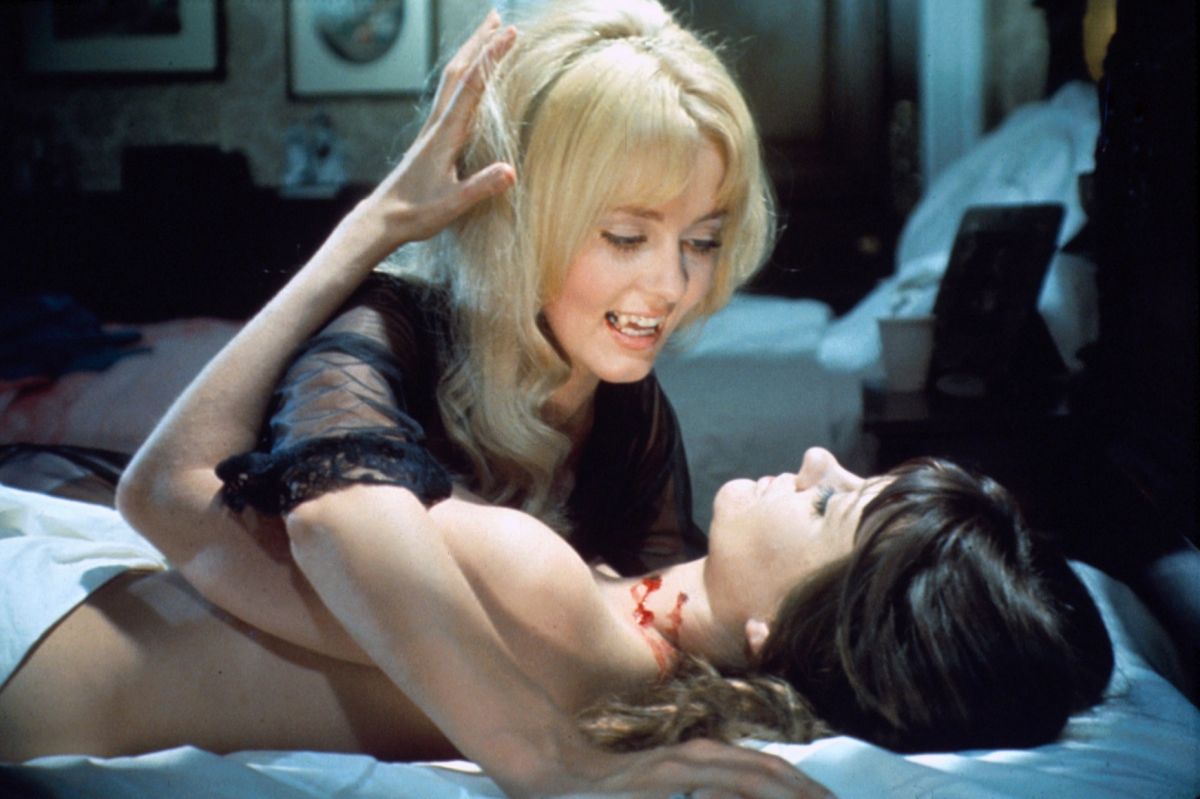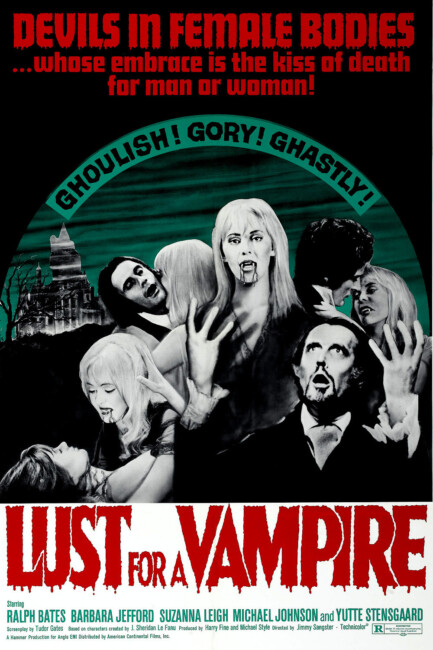UK. 1971.
Crew
Director – Jimmy Sangster, Screenplay – Tudor Gates, Producers – Tudor Gates & Michael Style, Photography – David Muir, Music – Harry Robinson, Music Supervisor – Philip Martell, Makeup – George Blackler, Art Direction – Don Mingaye. Production Company – Hammer.
Cast
Michael Johnson (Richard Lestrange), Yutte Stensgaard (Mircalla/Carmilla Karnstein), Ralph Bates (Giles Barton), Suzanna Leigh (Janet Mayfair), Helen Christie (Miss Simpson), Barbara Jefford (Countess Herritzen), Mike Raven (Count Karnstein), David Healy (Raymond Polley), Harvey Hall (Inspector Heinrich)
Plot
1830. The horror writer Richard LeStrange arrives in the village below Castle Karnstein where he becomes fascinated by the legend of the Karnsteins. Meanwhile, Carmilla Karnstein checks into the local girl’s school under the name Mircalla where she starts seducing and drinking the blood of the other girls. As the school tries to cope with the sudden rash of dead bodies, LeStrange falls in love with Carmilla and tries to persuade her to forsake her vampire ways.
Lust for a Vampire was the second (and weakest) of the trilogy of films that Hammer adapted from J. Sheridan Le Fanu’s classic vampire short story Carmilla (1872). The series started with The Vampire Lovers (1970) and was followed by Lust for a Vampire and then Twins of Evil (1971).
Hammer had made its name from 1957 onwards with new colour versions of old Universal classics with The Curse of Frankenstein (1957), Dracula/The Horror of Dracula (1958), The Phantom of the Opera (1962) and The Two Faces of Dr. Jekyll (1960). This in turn paved the way for various imitations and a string of Frankenstein and Dracula sequels. In the next decade, the burst of screen permissiveness that the 1960s brought allowed Hammer films to become much more sexually overt and let fly with the repressed sexuality that was only implied in their earlier films.
However, with Hammer having opened the closet door, the resulting films – Lust for a Vampire being the prime example – only ended up reeking with a cheap air of adolescent masturbatory fantasy. Lust for a Vampire looks exactly like what one would expect of a teenage boy’s sexual fantasy of lesbianism – all incredibly well stacked women fondling one another in mutual embrace. A parade through the dormitory at night is filled with impossibly nubile girls in a decorous state of undress; women hug and kiss the camera lens – it even zooms into closeup on them lasciviously licking their lips. The very overtness of the sexuality dooms the film – it lacks any subtlety. The casting of Danish blonde Yutte Stensgaard is case in point – she bursts with such obtrusive sexuality that she kills the subtle seductiveness Carmilla was meant to represent in the original story. If Lust for a Vampire had been made back during Hammer’s repressed period where all the sex were left implied, it would have been a far better film.

The script is a jumble of potentially good ideas – the character of the horror writer who is forced to suddenly confront what he cynically treats as fiction as being real, Carmilla torn between her nature and human love – which are carelessly tossed aside. The script is even a jumble of inconsistencies on its own level – it is stated the Karnsteins are not affected by fire but the climax celebrates their destruction among the burning of their castle; it is mentioned how the Karnsteins must return to their grave at night but the film avoids any mention of how Mircalla manages to sneak out of the girl’s school to return to her grave.
Someone like a Terence Fisher may have been able to make a classic out of it, but Jimmy Sangster is not a Terence Fisher. Sangster was screenwriter on many of the aforementioned Hammer remakes and made his directorial debut with the limpid The Horror of Frankenstein (1970). Sangster’s approach is to treat Lust for a Vampire as a 1960s mod film, adding spacey love songs and colour filters as the two leads principals make love. The film is painfully lacking in the stature that Jimmy Sangster brought to the genre as writer of various early Hammer classics like Dracula, The Curse of Frankenstein and The Revenge of Frankenstein (1958). His lip-licking point-of-view shots are just tacky.
Jimmy Sangster’s other genre scripts are:– X the Unknown (1956), The Curse of Frankenstein (1957), Dracula/The Horror of Dracula (1958), The Revenge of Frankenstein (1958), The Man Who Could Cheat Death (1959), The Mummy (1959), The Brides of Dracula (1960), the psycho-thrillers A Taste of Fear/Scream of Fear (1961), Paranoiac (1963), Maniac (1963), Nightmare (1964), Hysteria (1965), The Nanny (1965) and Crescendo (1970), and Dracula – Prince of Darkness (1966), all for Hammer. Sangster’s non-Hammer scripts are the medical vampire film Blood of the Vampire (1958), the alien invasion film The Trollenberg Terror/The Crawling Eye (1958), Jack the Ripper (1959), the Grand Guignol psycho-thriller Whoever Slew Auntie Roo? (1972), the tv movie psycho-thrillers A Taste of Evil (1971) and Scream Pretty Peggy (1973), the occult tv movie Good Against Evil (1977), the occult film The Legacy (1979), the spy tv movies Billion Dollar Threat (1979) and Once Upon a Spy (1980), the psycho-thriller Phobia (1980) and the story for Disney’s The Devil and Max Devlin (1981). As director, Sangster made two other films:– The Horror of Frankenstein (1970) and the psycho-thriller Fear in the Night (1972), all at Hammer.
Trailer here


